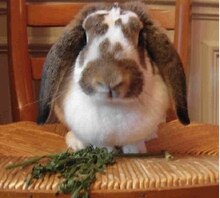French Lop

The French Lop is a breed of domestic rabbit developed in France in the 19th century from the selective breeding of English Lop and Flemish Giant stock.[1] The French Lop resembles the English Lop, but the French Lop is heavier in stature and does not have the exaggerated ear length of the English Lop. Weighing approximately 4.98 kg to 5.21 kg, it has an average lifespan of five to seven years.[citation needed] The French Lop is currently recognized by the American Rabbit Breeders Association (ARBA)[2] and by the British Rabbit Council (BRC).[3]
History[edit]
The French Lop was first bred as a meat rabbit, beginning around 1850 in France.[4] It is believed to have been produced by crossing two existing breeds, the English Lop and the Giant Papillon ("géant papillon français" or "Butterfly Rabbit of France").[clarification needed] The new breed became popular in neighbouring countries including the Netherlands, from which ten specimens were exported in 1933 to the UK for exhibition there.[4] By the 1960s, the French Lop had become a mainstream breed in the UK, and in 1970-1971, the first French Lops were imported into the United States.
Appearance[edit]
The French Lop is a very large rabbit, typically weighing around 10-15 pounds. They do not have a maximum weight in the show standard. Their ears are typically between 5 and 8 inches long and hang down below the jaw. They have a stout, thickset body and a large head. The front legs are short and straight and the hind legs are carried parallel to the body. The French Lop has a dense, soft coat that comes in two colour varieties: solid and broken. Within these categories can be found a number of different colour variations, including agouti, black, chinchilla, and fawn.
Behavior[edit]
Due to their relatively larger size in comparison to other breeds, the French Lop needs ample living space. They will not fare well in either outdoor or indoor cages. The French Lop is known to have a warm and relaxed temperament, and can even get along well with cats, dogs and young children. However, French Lops are not for the first-time rabbit owner because they are very large and can be hard to handle. They have very strong back legs, and can cause injury to the handler unintentionally. This said, French Lops are still rabbits. Care must be taken not to startle them, as they can still have heart attacks from fear.
See also[edit]
References[edit]
- ^ "Bealepark - Wildlife". Archived from the original on 26 March 2009. Retrieved 30 January 2009.
- ^ "ARBA Recognized Breeds". American Rabbit Breeders Association. Retrieved 21 November 2022.
- ^ "Breed Standards 2021-2025" (PDF). British Rabbit Council. Retrieved 21 November 2022.
- ^ a b "Rabbits: French Lop Rabbit". Archived from the original on 18 February 2009. Retrieved 30 January 2009.
Information[edit]
- Pet Planet Small Breed Profile
- Beale Park Wildlife - French Lop Rabbit
- Omlet Rabbit Breeds Info - French Lop
- French Lop Rabbit Breed History
- Rabbit Breeds Information


 French
French Deutsch
Deutsch